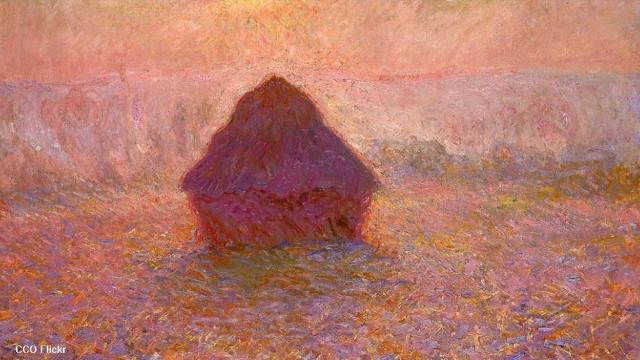Two record-shattering art sales hit auction houses this past week and it's hard to understand why. What accounts for Sotheby's in New York raking in $110 million for just one of Claude Monet's 25 haystack paintings? And why was Christie's in London able to unload just one of Jeff Koons' three stainless steel castings of balloon animals – a bunny – for $91 million? Both transactions soared beyond expectations. Why?
What price glory?
What makes Haystacks so special? Monet is known for picturing his subjects in changing light. You might say he was obsessive about it, having rendered 50 versions of London's Waterloo Bridge and 26 versions of Rouen Cathedral in Normandy.
Painting the same scene over and over at different times to study the effects of light make his effort a research project, not art. It's as if he were channeling Leonardo da Vinci who famously said that painters should begin every canvas with a wash of black because everything in nature is dark except when exposed to the light. Of course, Leonardo was part scientist and by the look of it, so was Monet.
Shining a light on the art market
But is an analysis of light as it shines on haystacks worth $110 million? Do mountainous mounds of hay say anything beyond the look of the sun on them? Another of Monet's studies of light seem more worthy of attention. His Women in the Garden is also about illumination.
but it's about more than that. What you see is a group of figures ambling through a garden in flowing gowns that take on the look of the surrounding breeze-blowing flowers. By picturing the way errant rays of the sun filters through the foliage onto the women's gowns, Monet makes the point that Mother Nature and humankind are not only one, but their very existence is also fleeting. The words of Francis Bacon come to mind. He said the job of the artist is always to deepen the mystery. Monet haystacks do the opposite. He exposes them to light.
The real deal
Perhaps the painter who best pictured both light and mystery is Jan Vermeer who gave his subjects an air of secrecy, of hidden meaning. I'm thinking of Young Woman with a Water Jug.
What you see is a girl standing by a kitchen window. Rays of the sun filter softly through the leaded glass panels onto her arm and shoulder and starched cap. Vermeer also reflects some rays on objects on a nearby table, as if to remind us that the setting is a kitchen. But he did more than shine on the subject and make her glow. He turned her away from her chores to peer out the window, leaving you to wonder what distracted her.
But with Jeff Koons' Rabbit, like Monet's Haystacks, there is no mystery at all, nothing to ponder. Emptier art I can't imagine.
![Jan Vermeer's Young Woman with a Water Jug [Image Source: wikipedia commons. Photographer Sailko] Jan Vermeer's Young Woman with a Water Jug [Image Source: wikipedia commons. Photographer Sailko]](https://staticr1.blastingcdn.com/media/photogallery/2019/5/19/660x290/b_502x220x82/jan-vermeers-young-woman-with-a-water-jug-image-source-wikipedia-commons-photographer-sailko_2266085.jpg)


